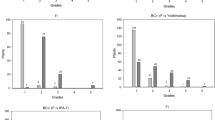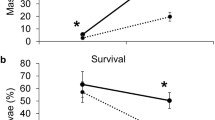Abstract
Inheritance of resistance to blackmold, a disease of ripe tomato fruit caused byAlternaria alternata, was studied in two interspecific crosses. The parents, F1 and F2 generations of a cross between the susceptibleLycopersicon esculentum Mill. cultivar ‘Hunt 100’ and the resistantL. Cheesmanii f.typicum Riley accession LA 422, and the parents, F1, F2, F3, and BC1 P2 generations of a cross between the susceptibleL. Esculentum cv. ‘VF 145B-7879’ and LA 422 were evaluated. The following disease evaluation traits were used: symptom rating (a symptom severity rating based on visual evaluation of lesions), diseased fruit (the number of diseased fruits divided by the total number of fruit scored), and lesion size (a function derived from the actual lesion diameter). Generation means analysis was used to determine gene action. The data of the ‘Hunt 100’ × LA 422 cross fit an additive-dominance model for all three traits. The ‘VF 145B-7879’ × LA 422 cross data best fit a model that included the additive × additive and additive × dominance interaction components for the trait diseased fruit, whereas higher-order epistatic models would have to be invoked to fit the data for the traits symptom rating and lesion size. A minimum of one gene segregated for all three traits. Broad-sense heritability estimates ranged from 0.09 to 0.16 for all three traits, indicating that selection for improved resistance to blackmold will require selection on a family performance basis.
Similar content being viewed by others
References
Butler EE (1959) Fungi and rots in California canning tomatoes. Plant Dis Rep 43:187–192
Casler MD (1982) Genotype × environment interaction bias to offspring-parent regression heritability estimates. Crop Sci 22:540–542
Davis RM, Marois JJ, Mauk P (1990) Control of tomato blackmold with canopy management. Phytopathol News Views 13:6
Fehr WR (1987) Principles of cultivar development, vol 1: theory and technique. Macmillan Publ Co, New York
Frey KJ, Horner T (1957) Heritability in standard units. Agron J 49:59–62
Gamble EE (1962) Gene effects in corn (Zea mays L.): I. Separation and relative importance of gene effects for yield. Can J Plant Sci 42:339–348
Gardner CO, Lonnquist JH (1959) Linkage and the degree of dominance of genes controlling quantitative characters in maize. Agron J 51:524–528
Garvey TC, Hewitt J (1984) A survey ofLycopersicon cheesmanii for high soluble solids. Tomato Gen Coop Rep 34:4–5
Gilbert NE (1973) Biometrical interpretation. Clarendon Press, Oxford
Gilchrist DG, Grogan RG (1976) Production and nature of a host-specific toxin fromAlternaria alternata f. sp.lycopersici. Phytopathology 66:165–171
Grewal RPS (1988) Genetic basis of resistance to zonate leaf spot disease in forage sorghum. Theor Appl Genet 76:550–554
Grogan RG, Kimble AA, Misaghi I (1975) A stem canker disease of tomato caused byAlternaria alternata f. sp.lycopersici. Phytopathology 65:880–886
Hall DH, Teviotdale BL, Paulus AO (1980) Blackmold of ripe tomato fruit. University of California, Div Agric Sci Leaflet No. 21154
Hayman BI (1958) The separation of epistatic from additive and dominance variation in generation means. Heredity 12:371–390
Koepsell PA (1968) The etiology ofGeotrichum andAlternaria molds and their effects on mechanical harvesting of tomato. PhD thesis, University of California, Davis
Lush JL (1940) Intra-sire correlations or regressions of offspring on dam as a method of estimating heritability of characteristics. Proc Am Soc Animal Prod 33:293–301
Mather K (1949) Biometrical genetics, 1st edn. Dover Publ, London
Mather K, Jinks JL (1977) Introduction to biometrical genetics. Cornell University Press, Ithaca, N.Y.
Mather K, Jinks JL (1982) Biometrical genetics: the study of continuous variation, 3rd edn. Chapman and Hall, London
Miller JC, Tanksley SD (1990) RFLP analysis of phylogenetic relationships and genetic variation in the genusLycopersicon. Theor Appl Genet 80:437–448
Miyao EM, Hall DH, Somerville P, Blaker N (1986) Fungicidal control of tomato blackmold under rainy conditions. Calif Agric 40:7–8
Paulus AO (1991) Alternaria stem canker (black mold). In: Jones JB, Jones JP (eds) Compendium of tomato diseases. APS Press, St. Paul, Minn.
Pearson RC, Hall DH (1975) Factors affecting the occurrence and severity of blackmold of ripe tomato fruit caused byAlternaria alternata. Phytopathology 65:1352–1359
Rick CM (1979) Biosystematic studies inLycopersicon and closely related species ofSolatium. In: Hawkes JG, Lester RM, Skelding AD (eds) The biology and taxonomy of the Solanaceae. Linnean Soc Symp Ser No 7, pp 667–676
Rick CM (1986) Germplasm resources in the wild tomato species. Acta Hortic 190:39–48
Rick CM, Yoder JI (1988) Classical and molecular genetics of tomato: highlights and perspectives. Annu Rev Genet 22:281–300
Shaw DV (1989) Variation among heritability estimates for strawberries obtained by offspring-parent regression with relatives raised in separate environments. Euphytica 44:157–162
Simmonds NW (1979) Principles of crop improvement. Longman, New York
Simmons EG (1967) Typification ofAlternaria, Stemphylium, andUlocladium. Mycologia 59:67–92
Smith JD, Kinman ML (1965) The use of parent-offspring regression as an estimator of heritability. Crop Sci 5:595–596
Strausbaugh CA, Murray TD (1989) Inheritance of resistance toPseudocercosporella herpotrichoides in three cultivars of winter wheat. Phytopathology 79:1048–1053
Thompson DL, Rawlings JO, Moll RH (1963) Inheritance and breeding information pertaining to brown spot resistance in corn. Crop Sci 3:511–514
Vogel KP, Haskins FA, Gorz HJ (1980) Parent-offspring regression in Indiangrass: inflation of heritability estimates by environmental covariances. Crop Sci 20:580–582
Wright S (1968) Evolution and genetics of populations, vol 1: genetics and biometric foundations. The University of Chicago Press, Chicago, Ill.
Zeng, Z, Houle D, Cockerham CC (1990) How informative is Wright's estimator of the number of genes affecting a quantitative character? Genetics 126:235–247
Author information
Authors and Affiliations
Additional information
Communicated by G. E. Hart
Rights and permissions
About this article
Cite this article
Cassol, T., St. Clair, D.A. Inheritance of resistance to blackmold (Alternaria alternata (Fr.) Keissler) in two interspecific crosses of tomato (Lycopersicon esculentum ×L. cheesmanii f.typicum). Theoret. Appl. Genetics 88, 581–588 (1994). https://doi.org/10.1007/BF01240921
Received:
Accepted:
Issue Date:
DOI: https://doi.org/10.1007/BF01240921




